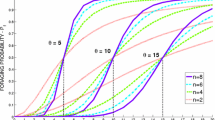Abstract
We present an agent-based simulation of a group of robots that source their energy from their surrounding environment. The robots forage their energy from localised sources, distributed in their surrounding environment and share energy with each other through “trophallaxis”. We investigate the effect of energy loss during energy transfer by considering two model configurations. In the first configuration, neighbouring pairs of robots shared the sum of their combined energy equally, at each time-step, without considering the energy levels of each robot. In contrast, in the second configuration, only donor and recipient robots averaged their energy. The roles of donor and recipient were defined by predetermined energy thresholds. Levy walk behaviour was employed to improve foraging ability. The results show that bio-inspired trophallaxis and Levy walk enhances the performance of the groups of scavenger robots. Our results indicate that trophallaxis is particularly effective considering energy loss during energy transfer. This suggests us the possibility to apply the trophallaxis models to the real robot systems where energy loss occurs during energy transfer.









Similar content being viewed by others
Explore related subjects
Discover the latest articles, news and stories from top researchers in related subjects.References
Greenwald E, Segre E, Feinerman O (2015) Simultaneous measurement of interaction patterns and food dissemination. Sci Rep 5:12496
Witkowski M (2007) Energy sharing for swarms modeled on the common vampire bat. Adapt Behav 15(3):307–328
Camazine S, Crailsheim K, Hrassnigg N, Robinson GE, Leonhard B, Kropiunigg H (1998) Protein trophallaxis and the regulation of pollen foraging by honey bees (Apis mellifera L.). Apidologie 29:113–126
Holldobler B, Wilson EO (1990) The ants. Belknap Press of Harvard University Press, Cambrige
Moritz RFA, Hallmen M (1986) Trophallaxis of worker honeybees (Apis mellifera L.) of different ages. Insectes Sociaus 33:26–31
Melhuish C, Kubo M (2007) Collective energy distribution: maintaining the energy balance in distributed autonomous robots using trophallaxis. Distrib Auton Robot Syst 6:275–284
Ngo TD, Schiler H (2008) Truly autonomous robots: hardware design for an energy trophallactic robot. Artif Life Robot 12:335–345
Wilkinson S (2001) Hungry for success-future directions in gastrobotics research. Ind Robot Int J 28(3):213–219
Ieropoulos I, Greenman J, Melhuish C. R, Horsfield I (2010) EcoBot-III: a robot with guts. In: The 12th international conference on the synthesis and simulation of living systems, pp 733–740
Melhuish C, Ieropoulos I, Greenman J (2006) Energetically autonomous robots: food for thought. Auton Robots 21:187–198
Cole BJ (1995) Fractal time in animal behavior: the movement activity of Drosophila. Anim Behav 50:1317–1324
Viswanathan GM, Bartumeus F, Buldyrev SV, Catalan J, Fulco UL, Havlin S, da Luz MGE, Lyra ML, Raposo EP, Stanley HE (2002) Lvy flight random searches in biological phenomena. Phys A 314:208–213
Bartumeus F, Catalan J, Fulco UL, Lyra ML, Viswanathan GM (2002) Optimizing the encounter rate in biological interactions: Levy versus Brownian strategies. Phys Rev Lett 88:097901
Nurzaman SG, Matsumoto Y, Nakamura Y, Koizumi S, Ishiguro H (2009) Biologically inspired adaptive mobile robot search with and without gradient sensing. In: 2009 IEEE/RSJ international conference on intelligent robots and systems, pp 142–147
Fujisawa R, Dobata S (2013) Levy walk enhances efficiency of group foraging in pheromone communicating swarm robots. In: Symposium on system integration, pp 808–813
Sutantyo DK, Kernbach S, Nepomnyashchikh VA, Levi P (2010) Multi-robot searching algorithm using Levy flight and artificial potential field. In: IEEE international workshop on safety security and rescue robotics
Kubo M, Melhuish C (2004) Robot trophallaxis: managing energy autonomy in multiple robots. In: Proceedings of towards autonomous robotics system, pp 77-84
Philamore H, Moonjaita C, Matsuno F (2017) Trophallaxis for group energy distribution in swarms of scavenger robots. In: The 2nd international symposium on swarm behavior and bio-inspired robotics
Author information
Authors and Affiliations
Corresponding author
Additional information
This work was presented in part at the 2nd International Symposium on Swarm Behavior and Bio-Inspired Robotics, Kyoto, October 29–November 1, 2017.
About this article
Cite this article
Moonjaita, C., Philamore, H. & Matsuno, F. Trophallaxis with predetermined energy threshold for enhanced performance in swarms of scavenger robots. Artif Life Robotics 23, 609–617 (2018). https://doi.org/10.1007/s10015-018-0497-z
Received:
Accepted:
Published:
Issue Date:
DOI: https://doi.org/10.1007/s10015-018-0497-z




